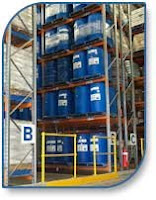Shelving comes in standard component sizes, to various heights, vertical shelf spacing and shelf depth, with ‘short span’ shelving that is usually 1 meter wide and ‘long span’ shelving of 3 meters or more. However, due to the different constraints in warehouses, shelving can be customised to fit specific requirements. There is a range of shelving, for instance,
Double Entry Tire Rack
The Double Entry Tire Rack is a type of Automotive Shelving
that is specifically designed for auto parts stores.
Product Dimensions (W x D x H):
60” x 42” x 84” with 3 beam levels that can hold approximately 48 tires.
Shelving with Open Frames

The Shelving with Open Frames is suited for the applications
where ventilation is required.
Product Dimensions (W x D x H):
36” x 12” x 87”with 329 kg capacity per shelf.
Boltless Shelving
The Boltless Shelving is also known as rivet shelving,
which is great for just about any bulky product that is hand loaded.
Product Dimensions (W x D x H):
96” x 18” x 84” with 4 levels with 1,000 lbs capacity per shelf.
Metro Wire Shelving

The Metro Wire Shelving is great for
food industry, labs, and even electronics.
Product Dimensions (W x D x H):
36” x 18” x 63” with 4 adjustable shelves.
Record Storage Shelving

The Record Storage Shelving is sized to
efficiently store standard boxes for archived records.
Product Dimensions (W x D x H):
42” x 30” x 99” with 5 shelves that can hold 60 1ft3 boxes including top shelf.
Multi-tier Shelving


The Multi-tier Shelving are shelving installed at multiple levels that allows economical use of cubic space, can accommodate a range of storage requirement, is ideal for archive storage and manual order picking applications.
With Multi-tier Shelving, the upper levels can be accessed with the incorporation of additional storage floors suspended from the shelving structure with walkways to allow pedestrian access for order picking, or by using fixed path trucks or order picking cranes.
The advantages of Shelving are:
- Comparatively inexpensive;
- Gives random access to stock; and
- Modular, interchangeable and is easily moved.
The disadvantages of Shelving are:
- Adjustment to shelf heights is not always easy after a period in use; and
- Separation of small quantities can restrict access, example, hand access between vertical shelf partitions spaced 50 mm apart is limited.
Although the range of shelving mentioned above have their advantages, in my opinion, I would prefer the Mobile Shelving System. I have found videos to illustrate the benefits of it.
Mobile Shelving System
By making use of the Mobile Shelving System, it can effectively save space as it eliminates the need for several access aisles. Due to the fact that the shelving moves along floor tracks, the space for only one aisle is needed. When an item is required, the particular shelving bay is identified and an adjacent aisle is created by moving the mobile units apart. Mobile shelving is opened and closed by either hand operated pull handles, hand wheel driven mechanical systems or electrically operated using small electric motors with push button control.
Additional benefits of this system include the efficient location of items and security - mobile units can be closed and locked together to prevent unauthorised access. Roller racking or mobile racking provides much more efficient space utilisation compared to static shelving or conventional filing solutions such as cabinets and cupboards. As well as saving space, mobile storage systems are ideal where sensitive or expensive items are stored because the shelving can be closed up and locked to restrict access.





















































